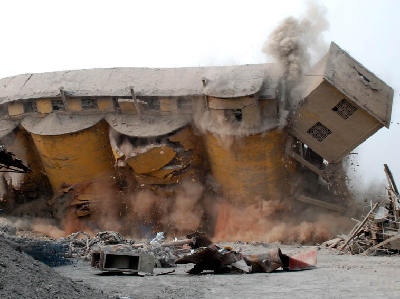The demolition on May 2, 2012, of an obsolete cement shaft kiln in Xiji Town, Zaozhuang City, Shandong Province.
Economic Transformation through Industrial Restructuring
China’s 12th five-year plan (2011-2015) on national economic and social development, approved at the Fifth Plenary Session of the 17th CPC Central Committee, explicitly states that fast-tracking transformation of the nation’s economic growth pattern is a main channel for China’s development in the coming five years. The core of economic growth pattern transformation lies in three aspects: Firstly, demand structure. Economic growth should depend on consumption, investment and export rather than just on investment and export. Secondly, industrial structure. Economic growth should be boosted by the coordinated development of primary, secondary and tertiary industries rather than mainly by secondary industry. Finally, input of multiple factors. Economic growth should depend on scientific advancement, high quality labor and innovated management rather than mainly on consumption of material resources.
When he assumed office in 2013, Chinese Premier Li Keqiang emphasized that the Chinese government would strive to promote sustained economic growth. “There are many problems facing China because it is such a large country, but the priority is still sustaining economic development. If we want to achieve the goal set for 2020, we must realize an estimated average annual growth of 7.5 percent. That will not be easy. But we have the advantage of strong domestic demand. So the key is to promote transformation of our economic growth pattern and form a new driving force with the combination of dividends of reform, the potential of domestic demand and innovative activities to build an upgraded Chinese economy,” said Premier Li.
Against the backdrop of the global economic recession, the world is seeking to glean more opportunities from the development of the world’s second largest economy – China. French Ambassador to China Sylvie Bermann said that the measures adopted by the Chinese government meet the needs of a world in plight. The upgraded Chinese economy is of great significance to the world’s interests, Bermann said.
Eliminating Overcapacity
The Decision on Major Issues Concerning Comprehensively Deepening Reforms that was approved at the Third Plenary Session of the 18th CPC Central Committee explicitly states that China must build on the paramount reality that it is in the primary stage of socialism and will long remain so while comprehensively deepening reforms. In light of the Decision, efforts should be made to promote the healthy development of strategic emerging industries and advanced manufacture industries, and to accelerate the transformation and upgrade of traditional industries. This latter is particularly significant today, as it has become apparent that the Chinese economy can achieve sustained development only through transformation and upgrading.
“The key to realizing quality, efficient and sustainable economic development is to deepen strategic industrial restructuring, with the focus on reforming and upgrading traditional industries. Overcapacity has become a stumbling block to our economic development. It is time to take action,” said Li Yizhong, member of the National Committee of the Chinese People’s Political Consultative Conference (CPPCC) and former Minister of Industry and Information Technology. According to statistics, China’s industrial capacity utilization rate in the first half of 2013 was at its lowest since the fourth quarter of 2009. What is worrisome is not only the difficulty in completely eliminating overcapacity, but also the fact that certain industries are still knowingly creating overcapacity. Take the steel and iron industry as an example. Statistics from the China Iron and Steel Association show that from January to November 2013, China produced a total of 710 million tons of crude steel, a year-on-year increase of 7.8 percent. A report released by the China Metallurgical Industry Planning and Research Institute forecast that China’s total crude steel production in 2013 would hit 780 million tons, while its consumption would be about 690 million tons, representing an overcapacity of nearly 100 million tons. China’s iron and steel industry is suffering medium to serious overcapacity and what is more, this is predictable.

He Daping, deputy to the National People’s Congress and vice chairman of the board and secretary of the Party Committee of Jiangsu Shagang Group’s Huaigang Special Steel Co., Ltd, suggested a solution to the problem of
